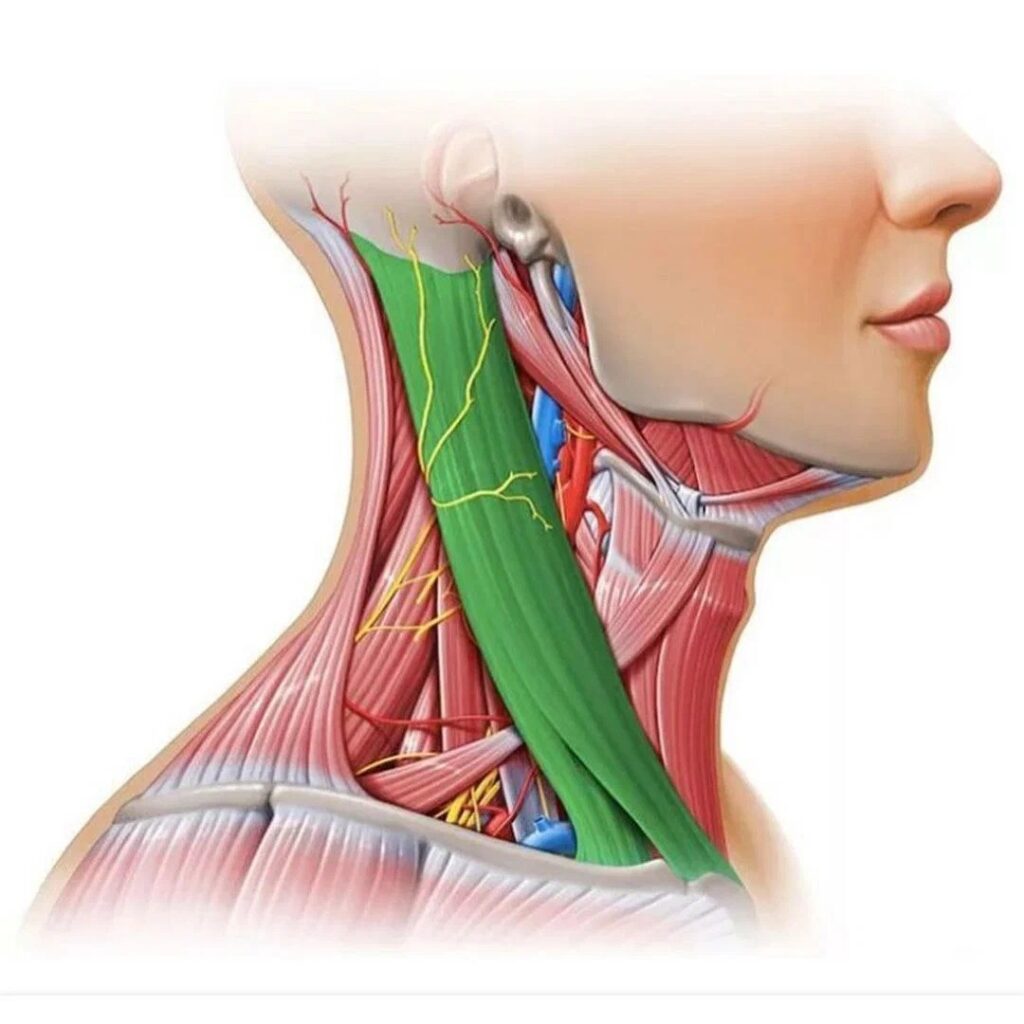Discover how the SCM impacts your facial appearance, posture, and overall health. Learn its benefits, how it can enhance your look, and why focusing on this key muscle makes a difference.
Table of Contents
The sternocleidomastoid muscle is not commonly included in beauty or wellness routines. Yet, this unique neck muscle is crucial not only for neck stability and movement but also for enhancing your facial appearance. Releasing tension in this can help redefine your facial contours, improve skin tone, and combat signs of ageing. In this post, we’ll dive into how the SCM influences facial structure, discuss its benefits, and explore why focusing on this muscle can be a game-changer in your facial care routine.
What is the Sternocleidomastoid Muscle?

The sternocleidomastoid muscle is a prominent muscle that sits on each side of the neck. Shaped like a “V,” it starts at the sternum (breastbone) and clavicle (collarbone) and extends up to the mastoid process, a bony area behind the ear on the temporal bone. The sternocleidomastoid becomes more visible when you turn your head to the side and is essential for head movement, posture, and neck stability. Its key functions include:
- Head movement: Helps turn the head from side to side and tilt it backward.
- Postural support: Maintains an upright head position.
- Neck stability: Keeps the head steady during various activities.
While the SCM’s role in movement is vital, its impact on facial aesthetics is where its true potential lies.
How the SCM Can Transform Your Face
Because of its location and structure, the SCM directly influences the skin, tone, and shape of the lower face and neck. When it’s tense or overly tight, it can shift the head and neck alignment, impacting your facial contours and skin appearance. Here’s how:
- Changes in Head Positioning: Tension in the muscle can cause a forward head posture. This tilt creates the look of a fuller neck, sagging jowls, and a softer jawline.
- Impact on Facial Symmetry: Tight muscles can contribute to asymmetry by affecting the balance of facial muscles. Over time, uneven muscle tone may lead to subtle facial asymmetries.
- Skin Wrinkles and Elasticity: Persistent SCM tension can cause horizontal neck lines and accelerate skin sagging around the jawline by restricting blood flow and lymphatic drainage, leading to reduced elasticity and early signs of ageing.
In summary, maintaining a relaxed, balanced SCM can lead to a more symmetrical, youthful, and lifted appearance.
How the sternocleidomastoid muscle Can Benefit Your Face?
Focusing on the SCM can improve facial aesthetics in several ways:
- Defined Jawline and Neck Contours
Reducing a tension helps bring the neck into a neutral position, which can decrease jowl sagging and enhance jawline definition. A relaxed SCM promotes a lifted, leaner look in the lower face and neck. - Improved Skin Quality and Lymphatic Drainage
Relaxing the SCM boosts blood flow and lymphatic drainage, contributing to smoother, healthier skin. Increased circulation delivers nutrients to skin cells, aiding in repair and creating a fresh, revitalised appearance. - Balanced Facial Structure
Working on the SCM encourages proper posture, which positively impacts facial alignment. Balanced alignment ensures evenly toned facial muscles, minimising strain on specific areas and supporting a harmonious look. - Reduced Neck and Facial Tension
Releasing SCM tension can also alleviate tightness in nearby facial muscles, reducing jaw tension, headaches, and eye strain for a more relaxed and refreshed expression.
Given the SCM’s importance for both posture and facial aesthetics, incorporating it into your wellness routine offers numerous benefits. Here are a few reasons to include SCM care in your regimen:
- Holistic Facial Care
- For those who prefer a holistic approach to facial aesthetics, the SCM is a crucial yet often-overlooked muscle. Unlike skincare products that only address the surface, exercises and massages target the deeper structures that support facial muscles and skin.
- Enhanced Postural Health
- As the SCM helps stabilise the head and neck, maintaining its balance can reduce strain on other muscles, preventing neck pain and stiffness. A healthy SCM supports an upright, elegant posture, improving overall alignment and adding grace to your appearance.
- Preventative Ageing Strategy
- Addressing SCM tension early on can prevent premature ageing signs such as jowl sagging, neck wrinkling, and jawline loss. Regular exercises and relaxation techniques provide a preventative approach to keeping youthful facial contours.
- Accessible and Easy to Work With
- The SCM is simple to locate and care for. Basic stretches, neck movements, and massages targeting this muscle can be done at home with minimal effort or equipment, making SCM care an easy addition to your self-care routine.
Conclusion
The sternocleidomastoid muscle is more than just a neck muscle—it’s a key player in facial aesthetics and posture. By understanding and caring for the SCM, you can enhance your facial contours, improve skin health, and achieve a balanced, relaxed look that reflects inner wellness. Adding exercises, stretches, and gentle massages to your routine can create noticeable changes in your appearance and comfort, making it a worthwhile addition to any beauty and wellness regimen.
For a more youthful, radiant face and balanced posture, don’t overlook the potential of this powerful yet understated muscle—the sternocleidomastoid.
References:
- American Council on Exercise (ACE). “Anatomy and Function of the Sternocleidomastoid Muscle.” ACE Fitness. Accessed 2023. https://www.acefitness.org
- Kendall, Florence Peterson, et al. Muscles: Testing and Function with Posture and Pain. 5th ed. Baltimore, MD: Lippincott Williams & Wilkins, 2005.
- Goodman, Craig C., and Susan Boissonnault Pathology: Implications for the Physical Therapist. Elsevier, 2017.
- Alghadir, Ahmad H., “The Effect of SCM Muscle Fatigue on Head and Neck Posture.” Journal of Musculoskeletal Science and Practice 36 (2018
- Haas, Matthias “Myofascial Release for SCM Hypertonicity and Postural Correction.” Journal of Bodywork and Movement Therapies